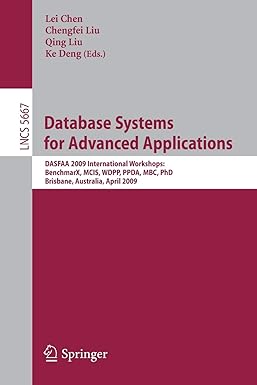Answered step by step
Verified Expert Solution
Question
1 Approved Answer
Unfortunately, directly representing A + B + C + D + E where + represents XNOR with a simple multilayer neural network using linear activation
Unfortunately, directly representing A B C D E where represents XNOR with a simple multilayer neural network using linear activation functions is impossible, as explained before. However, there are alternative approaches to approximate the desired behavior, and finding the optimal depth and width for each depends on several factors:
Multilayer Perceptron with custom activation:
Here, you train a network with nonlinear activation functions eg ReLU or sigmoid to approximate the XNOR behavior. However, there's no guarantee of perfect representation for all combinations.
Optimal depth and width: Experimentation is crucial. Start with a shallow network eg hidden layers and a moderate width eg neurons per layer and gradually increase if needed, considering training data size and computational resources.
Dedicated XORXNOR layers:
These specialized layers directly implement the XNOR logic, bypassing the limitations of single neurons.
Optimal depth and width: You might only need a single XORXNOR layer on top of a simple input layer. Focus on optimizing the previous layers in the network eg feature extraction and adjust the width based on data complexity.
Encoderdecoder architectures:
This approach involves encoding the input pattern A B C D E into a hidden representation and then decoding it to reconstruct the desired output for odd input sum, for even
Optimal depth and width: Experimentation is critical again. Start with a smaller architecture and gradually increase complexity based on performance and data size. Ensure the encoder can capture the nonlinearity of XNOR and the decoder accurately reconstructs the output.
General considerations:
Training data: More data can help the network learn the complex relationships better.
Computational resources: Deeper and wider networks require more data and computing power to train effectively.
Performance evaluation: Metrics like accuracy and loss on your specific task will help determine the optimal architecture.
Conclusion:
There's no onesizefitsall answer for the optimal depth and width. It depends on the chosen approach, data, and desired performance. Experimentation and careful evaluation are key to finding the best performing network for your specific application.
Feel free to ask any further questions you have about these approaches or specific implementation details! Im happy to help you explore this further.
Bard may display inaccurate info, including about people, so doublecheck its responses. Your privacy & BardOpens in a new window
chegg
Step : Represent XNOR using a multilayer neural network
Explanation:
The XNOR operation can be represented as a multilayer neural network. The XNOR operation is equivalent to an XOR operation followed by a NOT operation. The XOR operation can be represented as a combination of AND, OR and NOT operations. Therefore, the XNOR operation can be represented as a multilayer neural network with layers representing the AND, OR and NOT operations.
Step
Step : Determine the optimal depth and width for the network
Explanation:
The depth of the network is determined by the number of layers in the network. Since the XNOR operation can be represented as a combination of AND, OR and NOT operations, the network will have three layers, hence the depth is The width of the network is determined by the maximum number of nodes in a layer. In this case, the layer with the maximum number of nodes is the one representing the AND operation, which has two nodes. Therefore, the width of the network is
Step
Step : Represent A:B: :C: D: E using the multilayer neural network
Explanation:
The expression A:B: :C: D: E can be represented using the multilayer neural network for the XNOR operation. The inputs to the network are A B C D and E The output of the network is the result of the XNOR operation on these inputs.
neural network designed using Tensorflow Keras is given below. Students are instructed
to type the answers in the textbox of the portal.
n e t t f k e r a s l a y e r s S e q u e n t i a l
n e t add
t f k e r a s l a y e r s InputLayer inputshape
t f k e r a s l a y e r s Dense a c t i v a t i o n r e l u
t f k e r a s l a y e r s Dense a c t i v a t i o n r e l u
t f k e r a s l a y e r s Dropout
t f k e r a s l a y e r s Dense a c t i v a t i o n r e l u
t f k e r a s l a y e r s Dense a c t i v a t i o n r e l u
t f k e r a s l a y e r s Dense a c t i v a t i o n r e l u
t f k e r a s l a y e r s Dropout
t f k e r a s l a y e r s Dense a c t i v a t i o n r e l u
t f k e r a s l a y e r s Dense a c t
Step by Step Solution
There are 3 Steps involved in it
Step: 1

Get Instant Access to Expert-Tailored Solutions
See step-by-step solutions with expert insights and AI powered tools for academic success
Step: 2

Step: 3

Ace Your Homework with AI
Get the answers you need in no time with our AI-driven, step-by-step assistance
Get Started


